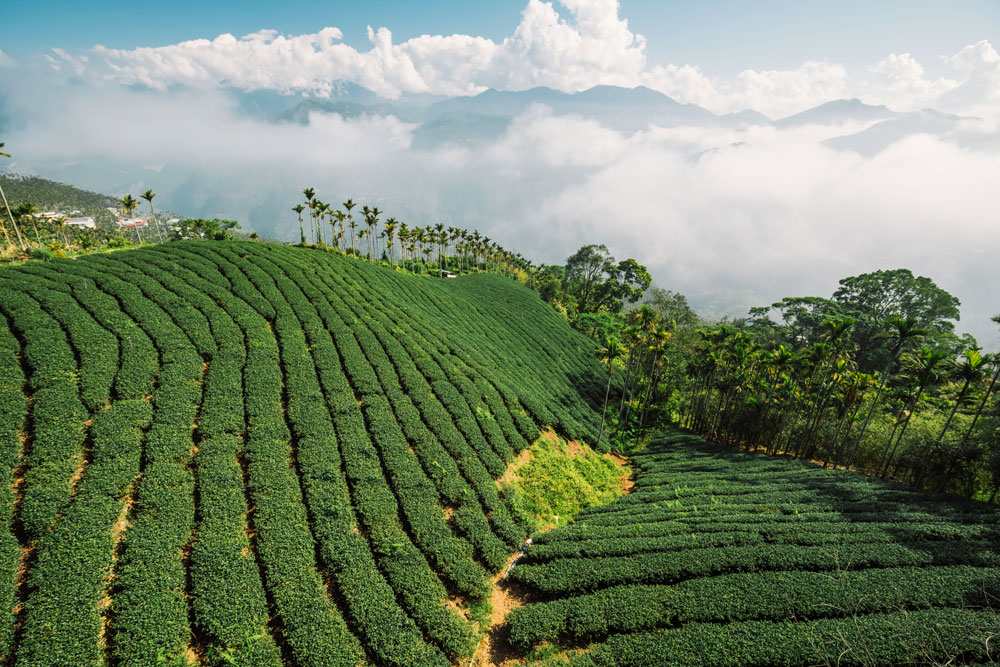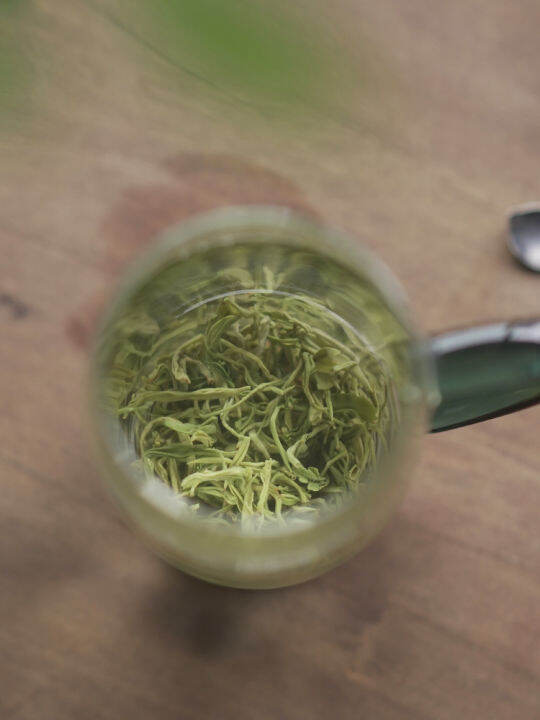Taiwanese High Mountain Tea: Altitude's Impact on Flavor & Health
What is Taiwanese High Mountain Tea (Gaoshan Cha)?
Taiwanese High Mountain Tea, also known as Gaoshan Cha (高山茶), is a type of oolong tea grown at high altitudes in the mountains of Taiwan. Generally, tea grown above 1,000 meters (3,300 feet) can be considered Gaoshan Cha. The unique climate and environment at these elevations contribute to the tea's distinctive flavor profile and health benefits. The most famous growing regions include Alishan, Lishan, and Yushan (Jade Mountain), Taiwan's highest peak. These areas are known for their cool temperatures, persistent fog, and fertile soil, all of which play a crucial role in shaping the tea's character.
Unlike teas grown at lower elevations, Gaoshan Cha benefits from slower growth due to the cooler climate. This slower growth allows the tea leaves to develop more complex flavors and aromas. The fog and mist that frequently envelop the mountains also help to keep the leaves moist and tender, preventing them from becoming bitter. The result is a tea that is exceptionally smooth, sweet, and aromatic.
Gaoshan Cha is typically lightly oxidized, which preserves its fresh, green character. The tea leaves are often hand-picked and carefully processed to ensure the highest quality. The specific processing methods can vary depending on the region and the desired flavor profile, but the emphasis is always on preserving the natural qualities of the tea.

The Altitude Advantage: How Elevation Affects Tea
Altitude is the defining factor that sets Gaoshan Cha apart from other teas. The higher elevation growing regions experience significantly different climatic conditions compared to lower altitudes. These conditions directly impact the tea plants' growth and the chemical composition of their leaves.
- Temperature: Higher altitudes have cooler temperatures, which slow down the growth of the tea plants. This slower growth allows the leaves to develop more complex flavors and aromas.
- Fog and Moisture: The mountains are often shrouded in fog and mist, providing ample moisture to the tea plants. This moisture helps to keep the leaves tender and prevents them from becoming bitter.
- Sunlight: While the mountains receive plenty of sunlight, the intensity is often diffused by the fog and clouds. This diffused sunlight promotes the production of chlorophyll, which contributes to the tea's vibrant green color.
- Soil: The soil in the high mountain regions is typically rich in organic matter and minerals, providing the tea plants with the nutrients they need to thrive.
These factors combine to create a unique environment that is ideal for growing high-quality tea. The altitude advantage is not just about the elevation itself, but also about the complex interplay of climate, moisture, sunlight, and soil that it creates.

Flavor Profile: What Does Gaoshan Cha Taste Like?
Gaoshan Cha is renowned for its smooth, sweet, and aromatic flavor profile. The tea typically has a light, floral aroma with hints of orchid or honeysuckle. The taste is often described as creamy, buttery, and slightly sweet, with a long, lingering finish. Unlike some other oolong teas, Gaoshan Cha is generally not bitter or astringent.
The specific flavor profile of Gaoshan Cha can vary depending on the region where it is grown and the specific processing methods used. For example, teas from Alishan are often known for their delicate floral aroma, while teas from Lishan may have a more robust, fruity flavor. However, all Gaoshan Cha teas share the common characteristics of smoothness, sweetness, and aromatic complexity.
The lack of bitterness is a key characteristic. The high moisture levels and diffused sunlight prevent the development of tannins, which are responsible for bitterness in tea. This makes Gaoshan Cha a very approachable and enjoyable tea for both experienced tea drinkers and newcomers alike.

Health Benefits: The Wellness Perks of High Mountain Tea
In addition to its delightful flavor, Gaoshan Cha offers a range of potential health benefits. Like other types of tea, Gaoshan Cha is rich in antioxidants, which can help to protect the body against damage from free radicals. These antioxidants, including catechins and polyphenols, are believed to contribute to various health benefits.
- Antioxidant Properties: The high concentration of antioxidants in Gaoshan Cha may help to reduce the risk of chronic diseases such as heart disease, cancer, and Alzheimer's disease.
- Improved Cardiovascular Health: Studies have shown that drinking tea can help to lower blood pressure and cholesterol levels, reducing the risk of heart disease.
- Enhanced Cognitive Function: The caffeine and L-theanine in tea can help to improve focus, concentration, and memory.
- Weight Management: Tea may help to boost metabolism and promote fat burning, aiding in weight management.
- Stress Reduction: The L-theanine in tea has been shown to have calming effects, helping to reduce stress and anxiety.
While more research is needed to fully understand the health benefits of Gaoshan Cha, the existing evidence suggests that it can be a valuable addition to a healthy lifestyle. It's important to note that tea should be consumed in moderation as part of a balanced diet.

How to Brew Gaoshan Cha for the Perfect Cup
Brewing Gaoshan Cha properly is essential to fully appreciate its delicate flavors and aromas. Here's a step-by-step guide to brewing the perfect cup:
- Water Temperature: Use water that is slightly below boiling, around 185-195°F (85-90°C). Using boiling water can scorch the leaves and result in a bitter taste.
- Tea-to-Water Ratio: Use about 3-5 grams of tea leaves per 8 ounces (240 ml) of water. Adjust the amount to your personal preference.
- Steeping Time: Steep the tea for 1-3 minutes for the first infusion. You can re-steep the leaves multiple times, increasing the steeping time slightly with each infusion.
- Brewing Vessel: A gaiwan or a small teapot is ideal for brewing Gaoshan Cha. These vessels allow you to easily control the steeping time and temperature.
- Preheating: Preheating your brewing vessel with hot water can help to maintain the water temperature and improve the flavor of the tea.
Experiment with different steeping times and water temperatures to find the perfect combination for your taste. Gaoshan Cha is a versatile tea that can be enjoyed both hot and cold.
Consider using filtered water for the best taste. Avoid using tap water, as it can contain minerals and chemicals that can affect the flavor of the tea. You can also explore different brewing methods, such as cold brewing, which can bring out different nuances in the tea's flavor.

Where to Buy Authentic Gaoshan Cha
Finding authentic Gaoshan Cha can be a challenge, as the market is flooded with imitations and lower-quality teas. Here are some tips for sourcing genuine Gaoshan Cha:
- Reputable Tea Vendors: Purchase tea from reputable tea vendors who specialize in Taiwanese teas. Look for vendors who can provide information about the origin and processing of their teas. Some well-known online retailers include Google search for "Taiwanese tea vendors", Amazon, and specialized tea shops.
- Direct from Taiwan: Consider purchasing tea directly from tea farms or cooperatives in Taiwan. This can be a great way to ensure authenticity and support local farmers.
- Certifications: Look for teas that have been certified by reputable organizations, such as the Taiwan Tea Research and Extension Station (TTRES).
- Price: Authentic Gaoshan Cha is typically more expensive than other types of tea. Be wary of teas that are priced too low, as they may be of lower quality or not genuine.
- Appearance: Examine the tea leaves carefully. High-quality Gaoshan Cha leaves should be whole, uniform in size, and have a vibrant green color.
When buying Gaoshan Cha online, read reviews and check the vendor's reputation. Look for detailed descriptions of the tea's origin, flavor profile, and processing methods. Don't be afraid to ask questions and request samples before making a purchase.
| Characteristic | Description |
| Origin | High-altitude mountains of Taiwan (above 1,000 meters) |
| Flavor | Smooth, sweet, floral, creamy |
| Aroma | Light, floral, hints of orchid or honeysuckle |
| Oxidation | Lightly oxidized |
| Health Benefits | Antioxidant properties, improved cardiovascular health, enhanced cognitive function |
By following these tips, you can increase your chances of finding authentic and high-quality Gaoshan Cha that you can enjoy for years to come.
So, steep yourself a cup of Gaoshan Cha and savor the unique taste of Taiwan's high-altitude magic!
-Hot Water
Comments
Post a Comment